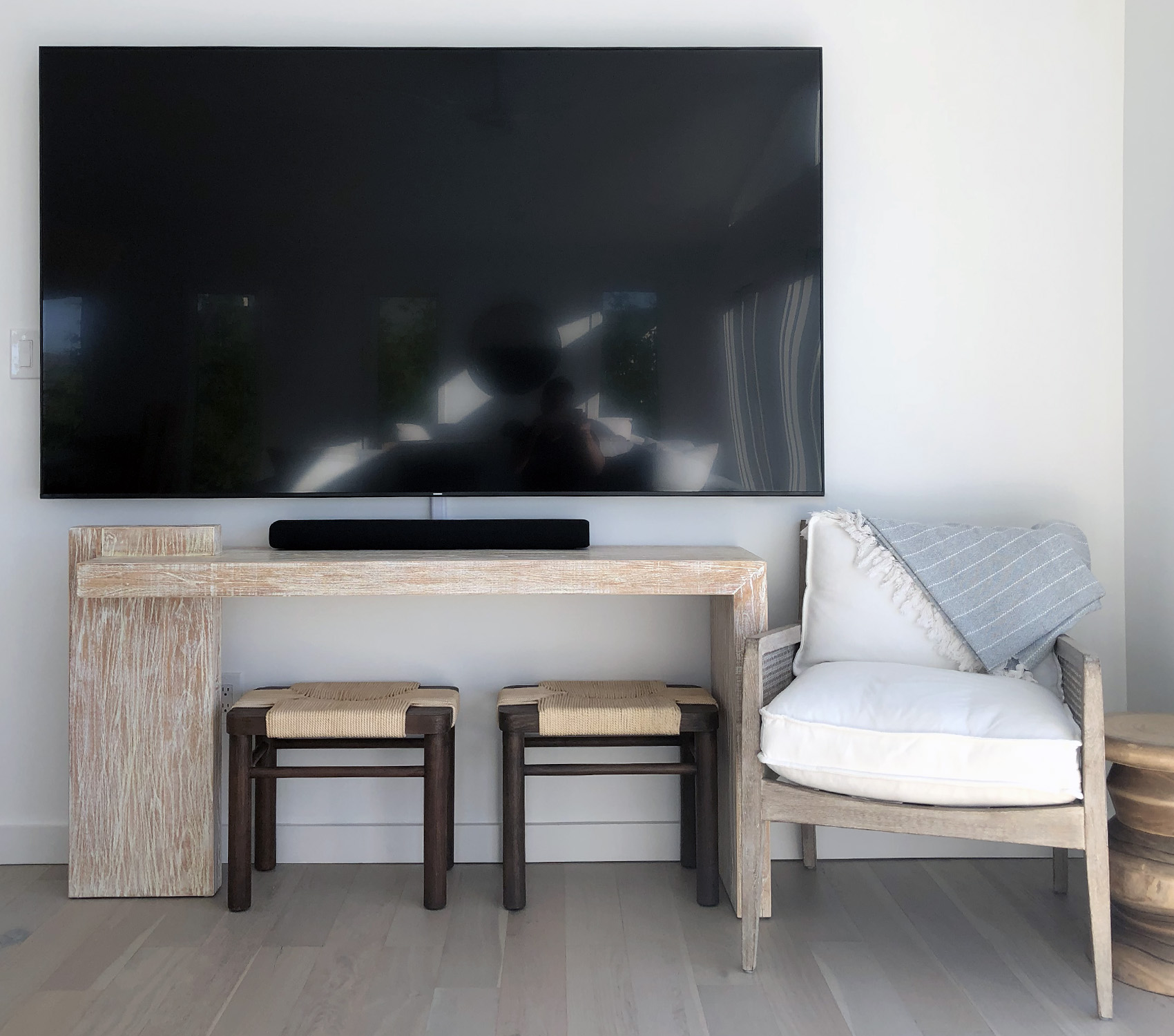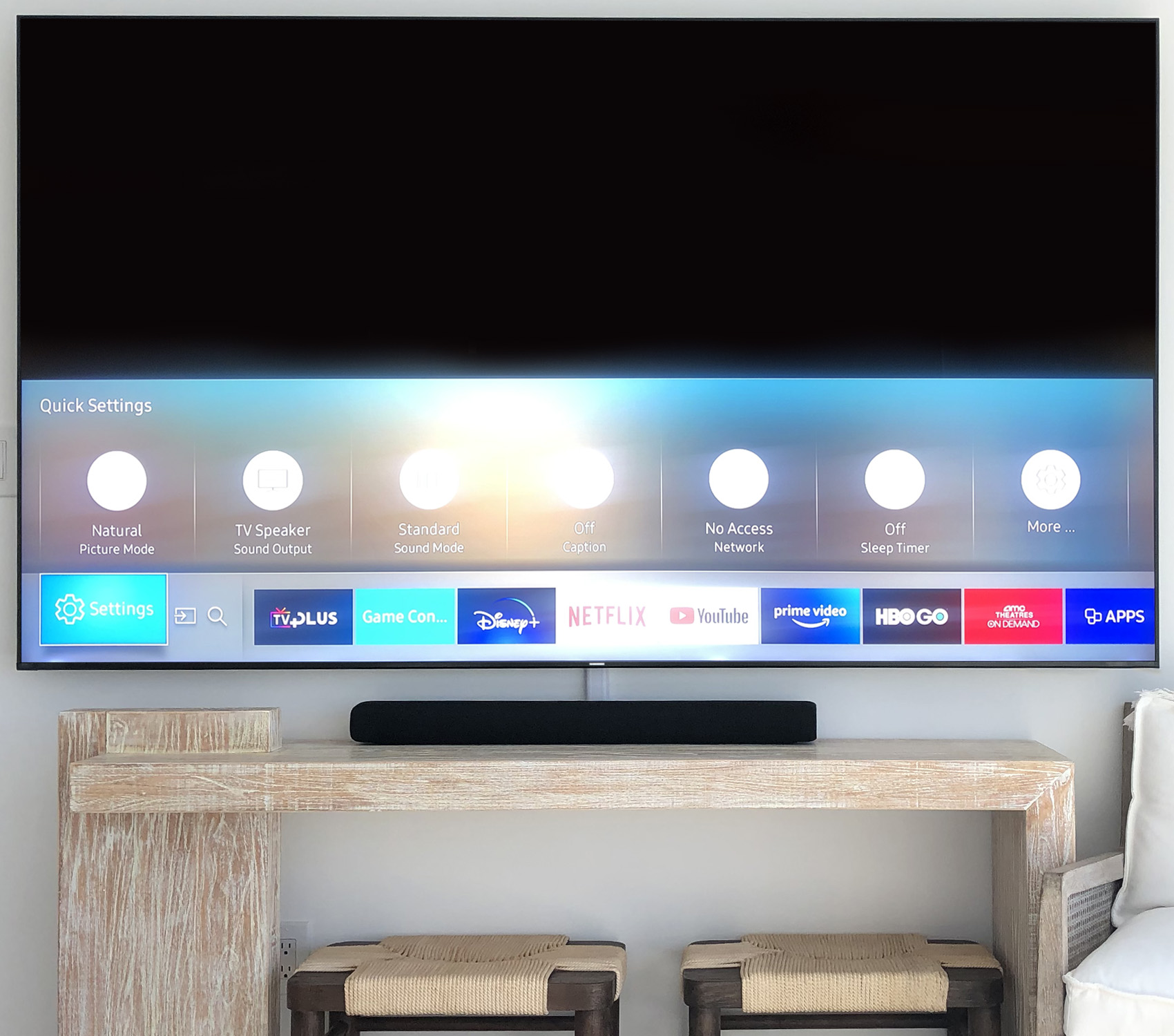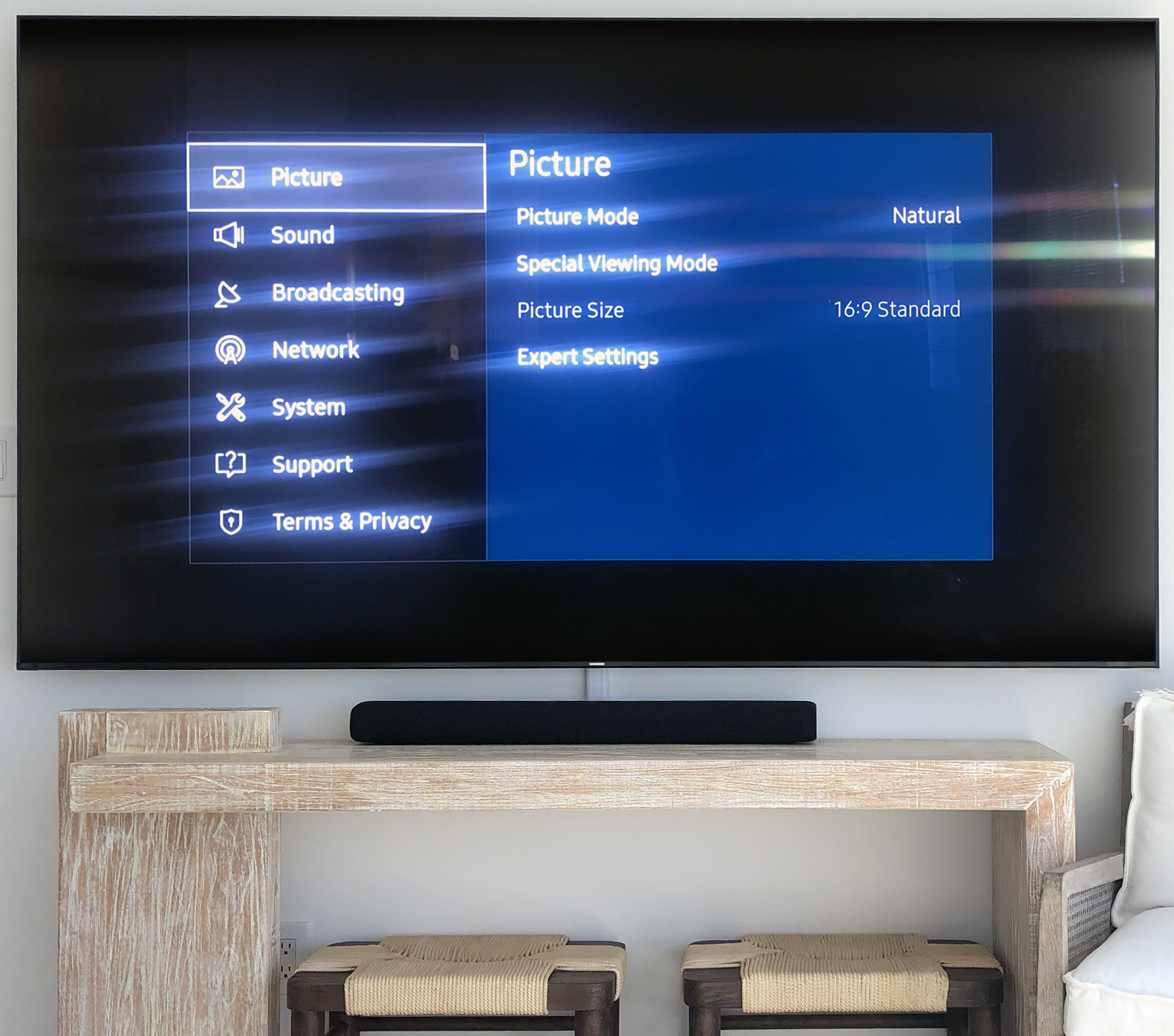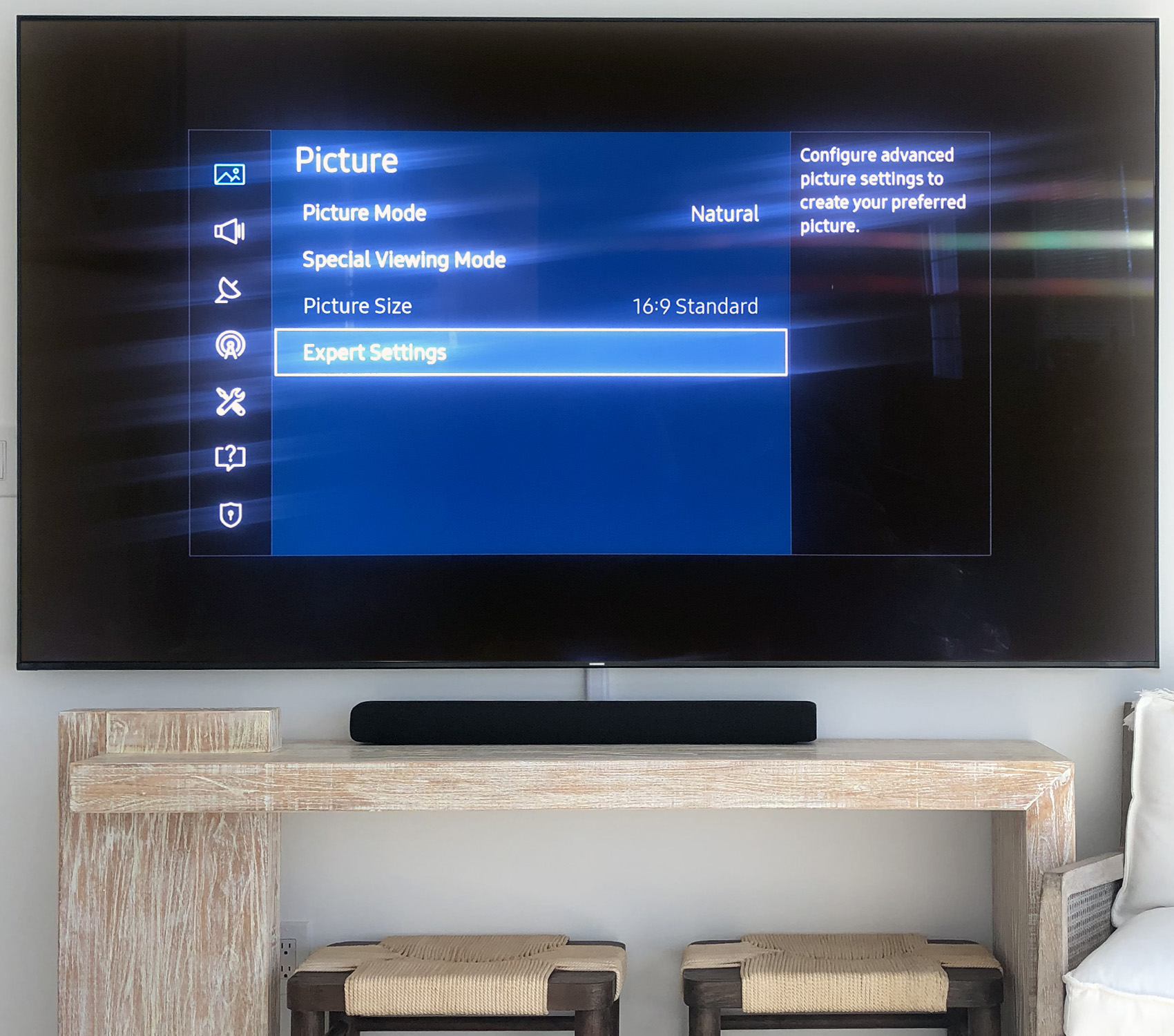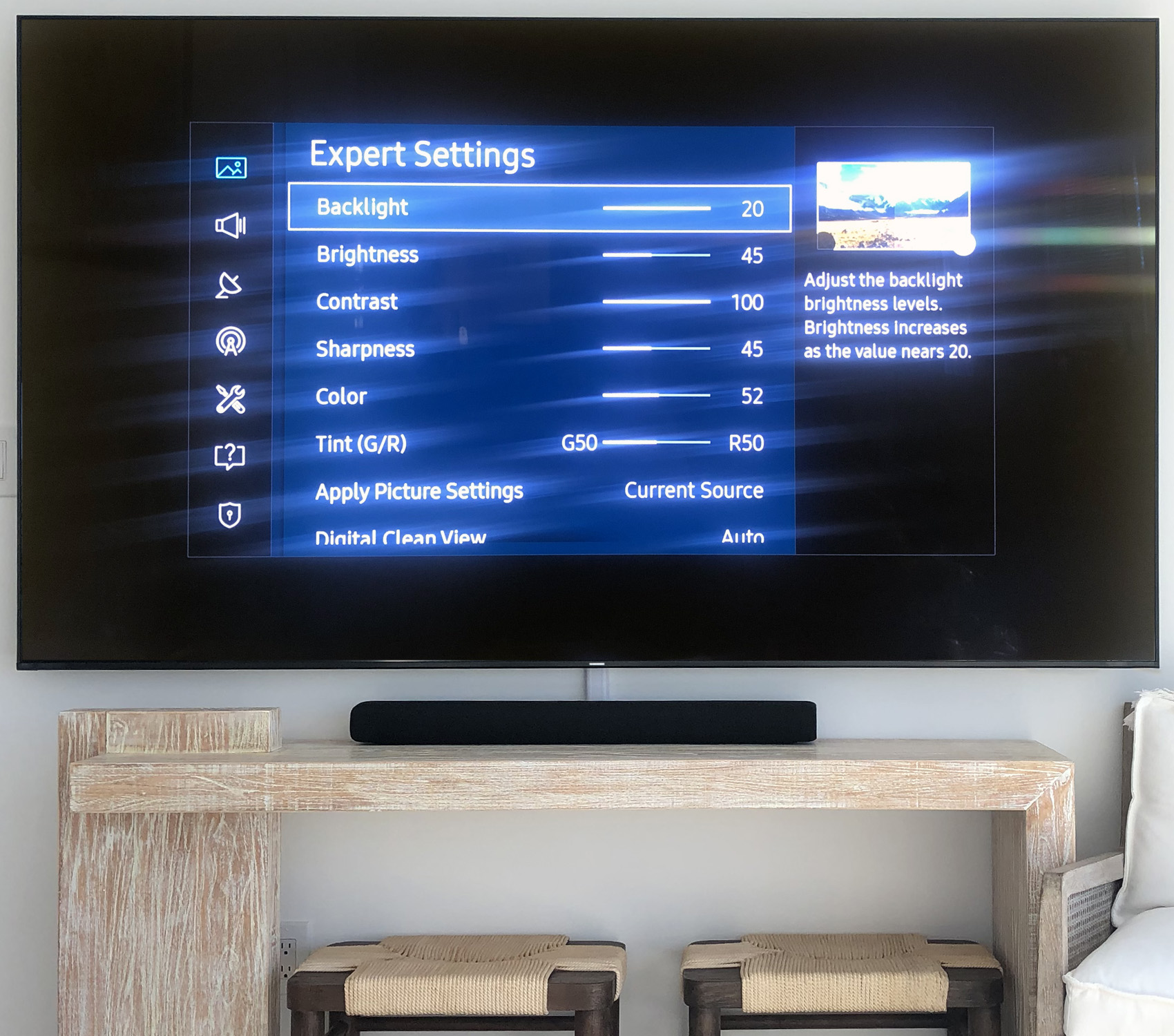The Best Picture Settings For A Samsung TV
Samsung manufactures some of the best quality televisions on the market. They offer a wide variety of sizes and models ranging from standard HD to ultra high quality OLED. I’ve tested hundreds of Samsung TVs because we use them in every new home we build. The picture quality is always very good right out of the box. But to get the best results possible I make a few adjustments in the picture settings. The best picture settings for a Sumsung TV are Contrast 45, Brightness 0, Sharpness 0, Color 50, Tint R50 and Backlight 20. These settings have always given me the best quality picture for the most devices.
These settings are the best all around for most situations, but not all. Every home, setup and room is different. Depending on lighting conditions, glare from windows and doors and what devices are used with the TV, you may want to alter the settings a little to achieve the best picture quality. In some cases this can even be done for a particular movie, show or game if it’s ultra dark or short on color. An example of this would be the last season of Game Of Thrones where certain scenes were so dark they couldn’t be scene on standard settings.
I recommend starting with these picture settings on all Samsung Tvs and then adjusting from there. Brightness and Contrast are the two settings that most people fine tune a bit. But Sharpness, Color, Tint and Backlight are important too.
In this article, we’ll discuss what all the picture settings for your Samsung TV mean and how to choose the best ones for various situations and devices.
How To Change Samsung TV Expert Settings
Changing the Samsung expert settings allows you to refine the picture quality in a number of ways. You can adjust things like Contrast, Brightness, Backlight, Sharpness, Tint and Color. Choosing the correct Mode for the TV and then adjusting the expert settings in the best way to get the most out of a Samsung TV’s picture quality.
If you’re watching a dark movie or a bright cartoon and the image doesn’t look quite right, don’t worry, you can fine-tune the picture’s settings until it’s exactly how you like it.
Navigate to Settings (All Settings), select Picture, and then select Expert Settings.
In your Samsung TV’s expert settings you’ll find a list of options that can be adjusted from 0 t 100.
Samsung TV Expert Settings
Once in the Samsung TV expert settings, you can fine-tune the picture quality by manually adjusting the picture’s Contrast, Brightness, Backlight, Sharpness, Tint and Color.
Each setting can be adjusted from 0 to 100. o Being the lowest setting while 100 is the strongest.
Here’s a breakdown of every setting and what they do:
- Contrast: Allows you to adjust the contrast, or dark and light elements of the picture. Contrast adjusts the ratio between dark blacks and bright whites on the screen. When contrast is low images appear more natural.
- Brightness: Changes the brightness of the screen. The darker the room is, the lower you want the brightness.
- Backlight: Lets you adjust how much light the screen produces. Turn this up if your room is very bright or down if the room is dark.
- Sharpness: Allows you to adjust how sharp the picture appears. Sharpness makes the outlines pop out or fade into the background. Less sharpness is a softer and more natural look.
- Color: Intensifies the saturation of colors on your screen. In addition to the sliding 0 to 100 scale, you can also choose standard which produces no hues, cool which has a blue hue, or warm which offers a more yellow coloring.
- Tint (G/R): Allows you to change the picture hue between green and red.
- Digital Clean View: Reduces picture noise and distractions such as flickering.
The optimal picture settings for a Samsung TV are Contrast 45, Brightness 0, Sharpness 0, Color 50, Tint R50 and Backlight 20.
Once you set the TV’s setting to these numbers, adjust them up and down based on the movie, game or show you’re watching, lighting conditions, viewing angle, glare, distance from the TV, etc. These settings are the best overall but every home is a little different.
More Picture Settings
In addition to a Samsung TV’s expert picture settings, which are the main settings you should adjust, there are also some additional settings called More Picture Settings.
Here’s a list of the additional settings you can adjust:
- Picture Clarity Settings: Enhance picture sharpness to optimize for fast-moving images: Auto Motion Plus, Blur Reduction, Judder Reduction, and LED Clear Motion.
- Smart LED: Control the brightness of individual areas on the screen to automatically maximize contrast.
- Film mode: Turn on Film mode to make frame transitions from older video sources smoother. This function is only available when the input signal is TV, AV, Component (480i, 1080i), or HDMI (1080i).
- HDMI Black Level: Adjust the black level to optimize the HDMI picture brightness and contrast.
- Dynamic Contrast: Automatically balance the contrast to prevent excessive differences between bright and dark areas.
- Color Tone: Select the color tone that best suits your viewing preferences.
- White Balance: Adjust the color temperature of the picture so that white objects appear brighter.
- Gamma: Adjust the mid-range brightness of the picture.
- RGB Only Mode: Fine-tune the saturation and tint of the red, green, and blue color channels.
- Color Space: Configure color space settings to refine the spectrum of colors on your screen.
- Reset Picture: Restore all picture settings to the factory default.
The Best Mode For A Samsung TV?
Samsung TVs come equipped with a variety of modes. Modes are preset setting configurations which make adjusting the picture quality fast and easy. When you select a new mode, the picture quality settings automatically change. My go to mode is Movie. It’s the best all around setting that produces a quality picture no matter the situation. I recommend starting with Movie mode settings and then adjusting as needed to tweak the picture quality a bit.
Selecting a mode is much faster and easier way to get the best picture quality instead of adjusting the TV’s expert settings yourself. You can also customize each mode manually after you select it.
First select a mode from the TV’s settings. Then, manually adjust the Contrast, brightness, Sharpness, Color, Tint and Backlight settings for the mode.
Whether you’re watching a scary movie in the dark or a bright cartoon during the day, Samsung has a picture mode that’s just right.
To change modes, navigate to Settings (All Settings), select Picture, and then select Picture Mode. Choose a picture mode that best suits your current situation.
Samsung TV Modes
Samsung TV modes are no different than if you set the settings manually in the TV’s advanced picture settings. When you select a mode, the TV’s Brightness, Contrast, Sharpness, Color, Tint and Backlight settings are automatically adjusted to settings set by Samsung.
- Standard: This is the Default mode that’s suitable for most viewing environments. It has moderate contrast, color and brightness settings.
- Dynamic: Pictures are brighter and clearer in bright viewing environments. This mode has higher saturation and contrast. Because of the brightness, energy usage is higher and eye strain can be an issue in dark rooms.
- Natural: Settings are between standard and dynamic with lower brightness and contrast than other modes. Reduces eye strain for a comfortable viewing experience.
- Movie: Minimum contrast and brightness. Movie mode has a warm tone that’s suitable for watching TV or movies in a dark or bright room.
- Filmmaker: Watch a movie or TV show without any changes to the picture settings just as the filmmaker intended.
Adjust your Samsung TV’s mode based on what your watching, when your watching it and the room’s lighting conditions. Settings make a big difference and definitely add to the TV’s picture quality.
If you don’t like changing the TV settings for a particular show or movie, keep it set to Movie. It’s the best all around setting that works day or night for games, shows and movies.
Samsung TV Picture Size
Another setting you can adjust on a Samsung TV is the picture size a.k.a. the aspect ratio. If you don;t like the black bars on the top and bottom of some movies, that’s an aspect ratio problem.
Note: Features vary depending on the model and year of your Samsung TV.
Once you’ve got the color looking perfect you can adjust the picture size and ratio depending on what you’re watching. This helps a lot because not all shows, movie or games are filmed with the same aspect ratio which means you’ll have black bars on the top and bottom or sides of the screen.
Navigate to Settings (All Settings), select Picture, and then select Picture Size Settings. Finally, select Picture Size. Choose a picture size that best fits the image you’re watching:
- Picture Size: Select the picture aspect ratio that best matches the image you’re watching on the screen.
- 16:9: Display the picture in widescreen aspect ratio. A great choice for wide screen movies.
- Custom: Customize the aspect ratio manually. This is good for older programs which filmed in odd ratios compared to modern TV shows and movies.
- 4:3: Display the picture in Standard (low-def) aspect ratio. Suitable for VHS and standard-def broadcasts.
- Fit to Screen: The full image will be displayed. No part of the image will be cut off.
- Note:The availability of this function depends on the Picture Size Settings.
- Zoom and Position: Adjust the picture size, position, or both. Note:This function is only available if the Picture Size is set to Custom. To change the picture position on analog channels, enlarge the picture first, and then change the position.
Game Mode
Game mode is a great setting when you’re playing high speed video games on your Samsung TV. Once activated, there may be a slight decline in the graphics quality but the picture will look smoother at speed.
Note:This feature is only available on select models.
Navigate to Settings > Game Mode and select Off, Auto, or On.
When Game Mode is set to auto, your TV will automatically turn on Game Mode when a connected game console is turned on and displayed on the screen.
Note: Game Mode is not available unless a game console is connected. Game consoles may also adjust your TV picture size and contrast to optimize the video game picture quality.
The Best Color Tone For Samsung TV
Samsung TV’s give you the ability to amplify the hues on your screen by selecting a color tone. I wouldn’t adjust these too much for regular viewing but they’re fun the try out and look nice on some older films or cartoons.
The color tones are basically a tint that changes all the color tones on the screen equally. The entire show, movie or whatever is on the screen will appear more blue, or pinkish.
First, navigate to and select Settings (All Settings), and then select Picture > Expert Settings. Then, select an option:
- Cool & Standard: These modes are only available when Picture Mode is set to Dynamic. Cool adds a cool blue hue to colors, while Standard adds no hue to colors.
- Warm1: Adds a warm pink hue to colors.
- Warm2: Adds a stronger pink hue to colors.
I would keep the TV set to standard most of the time but these settings are fun to try out.
3rd Party TV Calibration
High definition Samsung TVs have an incredible picture, but they may not look as good as they should if you have the wrong TV settings. To help you calibrate the TV to it’s optimal settings, there are 3rd parties that offer calibration software. By using the calibration software and the TVs adjustable settings you can fine-tune the picture quality to get the absolute best results possible for your model Samsung TV.
- The Xbox One gaming console includes a TV Calibration program in its display settings.
- Calibration discs are available for purchase that can be played on a Blu-ray player.
- Some Blu-ray movies include a calibration program along with the movie.
- Calibration programs are available for free or for sale online.
How To Find Samsung TV Expert Settings
In order to adjust a Samsung TV’s picture quality you first have to find the expert settings menu. Here’s a step by step guide showing you how to do it. Keep in mind that newer or older model Samsung TV’s may be slightly different. I took these steps from the newest 2022 model.
Navigate to Settings (All Settings), select Picture, and then select Expert Settings.
Step 1. Press The Home Button
First, press the home button on the Samsung TV remote control.
Then click the settings gear at the bottom of the screen. This will bring you to the TV’s settings menus.
Step 2. Select Picture
Next, select the Picture setting in the menu. It’s usually at the top.
In this menu you can adjust things like the aspect ratio and picture mode.
Step 3. Select Expert Settings
Scroll down to the bottom and select expert settings. This will take you to the menu where you’ll be able to adjust the picture settings.
Step 4. Adjust Expert Settings
Once in the expert settings menu you can adjust the TV’s picture settings.
Most settings are a sliding scale from 0 to 100. 0 Being the weakest while 100 is the maximum.
Step 5. Home
When your all done adjusting your Samsung TV settings, click the home button on your remote control to go back to the main screen.
Final Thoughts
Samsung TVs are some of the best quality televisions on the market with incredible HD picture quality. But if you want the best possible picture for your personal home entertainment system some fine-tuning of the TV’s picture settings are often necessary.
Movie mode is generally the best all around TV mode with expert settings set to Contrast 45, Brightness 0, Sharpness 0, Color 50, Tint R50 and Backlight 20.
Once you’ve set the TV to Move Mode and these settings, adjust from there based on what you’re watching, lighting conditions, the room, viewing angle, etc. There are lots of factors that can effect the picture quality of any TV. But you can get the most out of it by playing with the picture settings.
Summary: The Best Picture Settings For A Samsung TV
Samsung manufactures some of the best quality televisions on the market. They offer a wide variety of sizes and models ranging from standard HD to ultra high quality OLED. I’ve tested hundreds of Samsung TVs because we use them in every new home we build. The picture quality is always very good right out of the box. But to get the best results possible I make a few adjustments in the picture settings. The best picture settings for a Sumsung TV are Contrast to 45, Brightness 0, Sharpness 0, Color 50, Tint R50 and Backlight 20. These settings have always given me the best quality picture for the most devices.
These settings are the best all around for most situations, but not all. Every home, setup and room is different. Depending on lighting conditions, glare from windows and doors and what devices are used with the TV, you may want to alter the settings a little to achieve the best picture quality. In some cases this can even be done for a particular movie, show or game if it’s ultra dark or short on color. An example of this would be the last season of Game Of Thrones where certain scenes were so dark they couldn’t be scene on standard settings.
I recommend starting with these picture settings on all Samsung Tvs and then adjusting from there. Brightness and Contrast are the two settings that most people fine tune a bit. But Sharpness, Color, Tint and Backlight are important too.
If you have any questions or comments about the best Samsung TV picture settings email any time.

